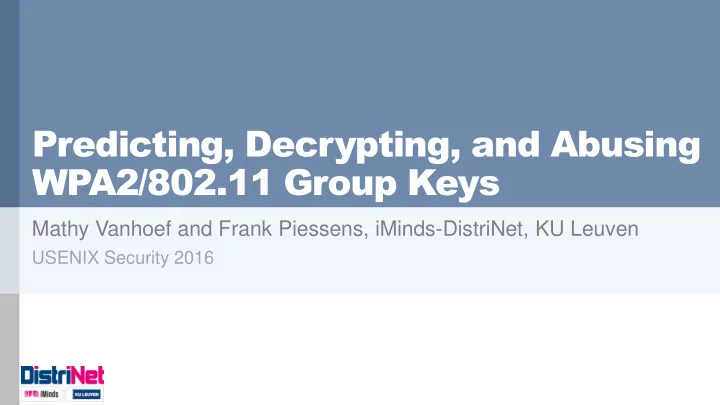

Predicting, Decrypting, and Abusing WPA2/802.11 Group Keys Mathy Vanhoef and Frank Piessens, iMinds-DistriNet, KU Leuven USENIX Security 2016
Security of Wi-Fi group keys? Protect broadcast and multicast Wi-Fi frames: All clients share a copy of the group key Security of groups keys not yet properly investigated! In contrast with preshared & pairwise keys … Analyze security of group key during its full lifetime! 2
Contributions: Security of Group Keys Flawed generation Force RC4 in handshake Inject & decrypt all traffic New Wi-Fi tailored RNG 3
Contributions: Security of Group Keys Flawed generation Force RC4 in handshake Inject & decrypt all traffic New Wi-Fi tailored RNG 4
How are group keys generated? Group key hierarchy: Sampled only at boot! AP generates public counter and Public Private secret master key counter master key Derive group temporal keys (GTKs) +1 Entropy only introduced at boot PRF-X If master key is leaked, all group keys become known Group Temporal Key (GTK) 5
How are random numbers generated? 802.11 standard has example Random Number Generator § 11.1.6a: “… can generate cryptographic - quality randomness” Annex M.5: “This solution is expository only” Inconsistent description of RNG’s security guarantees! How secure is the design of the 802.11 RNG? How many platforms implement this RNG? 6
802.11 RNG: Main Design The 802.11 RNG is a stateless function returning 32 bytes Collects entropy on-demand Entropy extracted from frame arrival times and clock jitter Deviates from traditional RNG design: No entropy pools being maintained Entropy only extracted from events when the RNG is being invoked 7
802.11 RNG: Entropy sources Frame arrival times: Collected by repeatedly starting & aborting 4-way handshake Problem: AP is blacklisted after several handshake failures Clock jitter and drift: Note: Router’s current time is leaked in beacons Problem: No minimum time resolution small clock jitter 8
Surely no one implemented this…? Weakened 802.11 RNG Depends on OS 9
Surely no one implemented this…? Weakened 802.11 RNG Depends on OS 10
MediaTek RNG: Linux-based APs Uses custom Linux drivers: Implements 802.11’s RNG using only clock jitter Uses jiffies for current time: at best millisecond accuracy RT-AC51U OpenCL ~3 mins GMK & GTK 11
Contributions: Security of Group Keys Flawed generation Force RC4 in handshake Inject & decrypt all traffic New Wi-Fi tailored RNG 12
Simplified 4-way hanshake 13
Simplified 4-way hanshake Group key encrypted and transmitted … … before downgrade attack detection! 14
Simplified 4-way hanshake Pairwise Cipher GTK encryption Group key encrypted WPA-TKIP RC4 and transmitted … AES-CCMP AES Key Wrap … before downgrade attack detection! 15
Downgrade attack 1. Rogue AP: Only advertise WPA-TKIP 2. Client picks WPA-TKIP 3. Encrypted with RC4! 4. Rogue AP detected 16
Attacking RC4 encryption of GTK RC4 Key: 16-byte IV ||16-byte secret key First 256 keystream bytes are dropped Recover repeated encryptions of GTK: Requires ~2 31 handshakes: takes >50 years Countermeasures: Disable WPA-TKIP & RC4 Send GTK after handshake 17
Contributions: Security of Group Keys Flawed generation Force RC4 in handshake Inject & decrypt all traffic New Wi-Fi tailored RNG 18
Abusing the group key: Hole 196? Attacker AP Victim (has GTK) Inject unicast IP packet in broadcast Wi-Fi frame Detected by “Hole 196” check Hole 196 check done at network- layer… … but an AP works at link -layer! 19
Forging unicast frames using group key Abuse AP to bypass Hole 196 check: Victim Attacker AP Sender Destination Data 20
Forging unicast frames using group key Abuse AP to bypass Hole 196 check: 1. Inject as group frame to AP Victim Attacker AP Flags Receiver FF: ⋯ :FF Sender Destination Data To AP 802.11 specific Encrypted using group key 21
Forging unicast frames using group key Abuse AP to bypass Hole 196 check: 1. Inject as group frame to AP 2. AP processes and routes frame Victim Attacker AP Flags Receiver FF: ⋯ :FF Sender Destination Data To AP 802.11 specific Decrypted using group key 22
Forging unicast frames using group key Abuse AP to bypass Hole 196 check: 1. Inject as group frame to AP 2. AP processes and routes frame Victim Attacker 3. AP transmits it to destination AP Flags Receiver Destination Sender Destination Data To STA 802.11 specific Encrypted using pairwise key 23
Forging unicast frames using group key Abuse AP to bypass Hole 196 check: 1. Inject as group frame to AP 2. AP processes and routes frame Victim Attacker 3. AP transmits it to destination 4. Victim sees normal unicast frame AP Flags Receiver Destination Sender Destination Data To STA 802.11 specific Decrypted using pairwise key 24
Forging unicast frames using group key Abuse AP to bypass Hole 196 check: 1. Inject as group frame to AP 2. AP processes and routes frame Victim Attacker 3. AP transmits it to destination 4. Victim sees normal unicast frame AP Flags Receiver Destination Sender Destination Payload To STA 802.11 specific Decrypted using pairwise key 25
Decrypting all traffic ARP poison to broadcast MAC address Poison both router and clients Targets network- layer protocols: IPv4, IPv6, … Countermeasure: AP should ignore frames received on broadcast or multicast MAC address. 26
Contributions: Security of Group Keys Flawed generation Force RC4 in handshake Inject & decrypt all traffic New Wi-Fi tailored RNG 27
An improved 802.11 RNG Entropy present on al Wi-Fi chips? Wi-Fi signals & background noise Spectral scan feature in commodity chips: Can generate 3 million samples / second First XOR samples in firmware Extract & manage resulting entropy using known approaches Additional research needed: performance under jamming? 28
Conclusion: lessons learned 1. Use a proper RNG 2. Let AP ignore group-addressed frames Don’t put “expository” security algos in a specification 3. Don’t transmit sensitive data before downgrade detection 4. Questions? 29
Recommend
More recommend